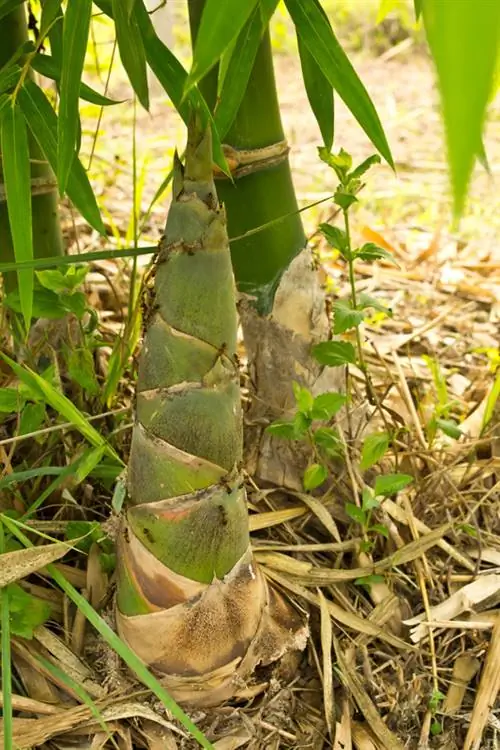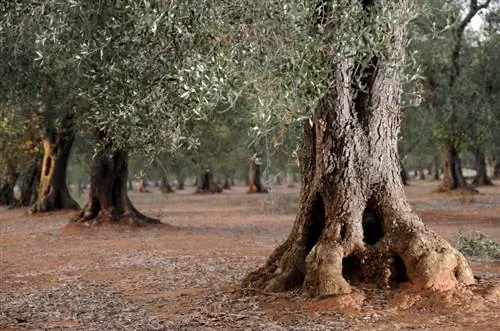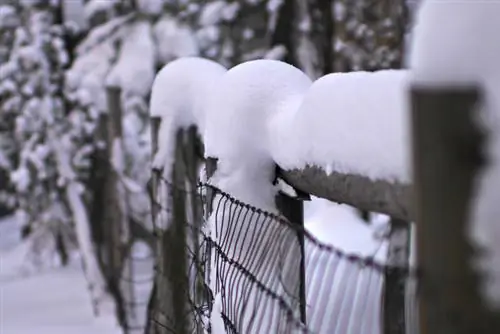- Author admin [email protected].
- Public 2023-12-25 17:45.
- Last modified 2025-01-23 11:21.
Zigzag bushes impress with their extraordinary growth. Their shape is determined by the branches in combination with the leaves. To ensure that the shrubs show their star-shaped flowers, you should pay attention to proper care and the right location.

How do I properly care for a zigzag bush?
The zigzag bush (Corokia cotoneaster) is a small shrub from New Zealand that is known for its extraordinary growth and star-shaped flowers. Proper care and a suitable location are crucial for its he alth: bright, semi-shady places, cool temperatures, permeable substrate and protection from waterlogging promote flowering.
Origin
Corokia cotoneaster, as the zigzag shrub is scientifically called, comes from the Argophyllaceae family. The shrub's natural distribution area is the forests of New Zealand. It occurs in the low to medium-high bush vegetation of coastal regions. The locations are exposed to wind.
leaves
Zigzag bushes develop silver-green foliage. The leaves are very small and ovate or elliptically developed. The edge of the leaf has coarse lobes that are cut more or less deeply. The leaf tip is tapered. On the underside the leaves are whitish due to the fine hairs. The petioles are noticeably long compared to the leaf blade. Their flattened shape makes them appear very wide.
Flowers
The bizarre bushes develop small flowers whose bracts are colored yellow. Each individual flower is formed from two circles of three bracts each. The flowers are clustered together in small groups of two to four. They are located in the leaf axils or at the end of a shoot and exude a faint scent that has a slightly sweet character. The flowering period of the wild-growing shrubs extends from December to January. Specimens cultivated in Central Europe bloom in late winter and spring. The flowers appear before the leaves emerge.
Growth
Zigzag bushes grow as small shrubs whose shoots are covered in white down. They shed their leaves in autumn and develop an unusual growth habit. After each leaf base and node, the growth direction of the shoot axis changes, resulting in a zigzag-shaped overall picture. The small leaves make the bushes appear bare.
While the cultivated specimens of Corokia cotoneatser grow between 150 and 250 centimeters high, the wild-growing shrubs in their original distribution areas reach heights of up to two meters. Their annual increase is small. This growth habit is an adaptation to the wind-exposed locations in the original distribution area, with the bushes remaining particularly low and compact in places with strong windy conditions.
Bonsai
Its slow growth rate and good pruning tolerance make the zigzag shrub the ideal plant for bonsai design. A cut is possible at any time. Zigzag bushes can be formed as a broom or cascade bonsai. The wiring used to create cascades does not cause any problems.
The first step in growing a bonsai is the design cut. It is used to give the bonsai a basic shape. To do this, you remove some large branches, although this decision is often difficult. This cut determines the future appearance of the tree.
In order to form a bonsai, care pruning is of great importance. Regularly remove the shoot tips so that the tree does not grow tall, but remains small and its crown branches out. A special variant is leaf pruning, in which all leaves are removed in summer. The zigzag bush develops new leaves that are smaller and fit better with the overall appearance.read more
Usage
The plant is considered an insider tip. Zigzag bushes are cultivated as houseplants, where they add special accents in the form of bonsai or shrubs. Their wild growth combined with the sparse foliage give the shrubs a dramatic character. They are suitable for beautifying terraces and balconies.
Zigzag bushes can be planted individually or in small groups of three in a container. Individually growing specimens form a tree-like shape if you cut the plant accordingly. If several plants grow in one pot, their trunks remain thin because of the limited space available. The arrangement appears bush-like. You can also combine the zigzag shrub with other woody plants or grasses.
Is zigzag bush poisonous?
Zigzag bushes do not contain any toxic substances. Leaves, flowers and fruits are harmless. The red fruits that develop on the plant in summer are tempting to eat. It is not discouraged, but the taste of the fruit is considered inedible. Therefore, you don't have to worry about your children or pets when cultivating Corokia cotoneaster. The plants pose no danger to cats, dogs and guinea pigs.read more
Which location is suitable?
The extraordinary shrubs like a bright location with sunny conditions all year round. A location in partial shade is ideal. In the hot summer months, the plants are grateful for a cool and shady place so that they do not lose too much liquid through evaporation. Zigzag bushes prefer cool temperatures that range between 15 and a maximum of 20 degrees Celsius.
In winter, the plants prefer a bright place on the windowsill, although the temperatures should be as cool as possible. A winter garden that offers temperatures between five and ten degrees Celsius is ideal. If the thermometer rises above this range in winter, flowering may stop. Good ventilation is important to prevent pests from spreading. The zigzag shrub is partially hardy, which is why it can also be overwintered outside in mild areas. But it should definitely receive winter protection.read more
What soil does the plant need?
The zigzag shrub likes a substrate with permeable conditions. It reacts sensitively to waterlogging, which is why you should equip the bucket with drainage. Humus-rich soil provides the plant with a good growth base. Potting soil is ideal. You can use the substrate pure or loosen it up for better permeability.
This material improves the substrate structure:
- clay granules
- Sand
- Pumice gravel
- Akadama
Zigzag bush in a pot
The shrubs are only cultivated in pots, as the plants would not survive the winter months outdoors. You can cultivate the plant as a bonsai in a shallow bowl.
Balcony
Zigzag bushes can be placed on the balcony or terrace during the summer months. They like bright and warm locations, but prefer a place out of the blazing sun. Windy conditions do not cause any problems for the plants. You can put the plants outside in spring when they are blooming. The nectar-filled flowers then serve as a valuable food source for bees and insects. Make sure that temperatures do not drop below 15 degrees Celsius during the day. On cold nights you should bring the plant inside in the evening.
Propagation
You can propagate your zigzag bush from seeds or cuttings. Sowing can be done all year round, although you should preferably sow the seeds in spring or summer. Then you can provide the seeds with enough light and warmth. Propagation via cuttings is more promising and easier. Offshoots are cut in spring so that the young plants have enough time to mature and grow until the onset of winter.read more
Sowing
Before you sow the seeds, they must be soaked in lukewarm water. Fill a saucer with tap water and let the seeds rest in it for 24 to 48 hours. Fill a planter with sowing soil that is loosened with sand or perlite. Press the seeds into the substrate, leaving them no deeper than one centimeter in the soil.
Place the plant pot in a bright and warm place. The seeds find ideal germination conditions at temperatures between 20 and 23 degrees Celsius. Keep the substrate evenly moist. To do this, you can cover the cultivation container with a transparent film. Ventilate the film daily, otherwise the seeds will quickly develop mold. Propagation via seeds is time-consuming and not always successful. Not all seeds germinate reliably.
Cuttings
Cut woody shoots from the plant. The cuttings should be between ten and 15 centimeters long. The lowest leaves are removed. Place the cuttings in a planter filled with potting soil and place it in a warm, bright place. Make sure that the substrate remains evenly moist. Waterlogging should be avoided, otherwise the shoot ends including the newly developed roots can rot.
As soon as the first fresh leaves appear, you can prick out the young plants and place one plant at a time in a larger planter. They then formed roots. If you pay attention to proper care and do not fertilize the plant in the first year, the offshoot will soon develop into an aesthetic shrub.
Cut the zigzag bush correctly
You don't necessarily have to cut the zigzag bush. If it has gotten out of shape and develops branches that are too long and disrupt the overall look, you can always shorten these branches. The plant tolerates cutting well and forms new branches at the interfaces. When cutting, make sure that you do not cut back into the old wood.
Before you bring the shrub into its winter quarters, we recommend shortening long shoots. This will prevent space problems and the shrub will require a little less energy. If you want to cultivate your zigzag bush as a bonsai, shape and design cuts are necessary.read more
Watering the zigzag bush
The houseplant likes a constantly fresh substrate. When watering, make sure that no waterlogging occurs. Before you water, the top layer of soil should be dry. The root ball must not dry out. Reduce the amount of water in winter because the shrub needs less water when it is dormant.
Fertilize zigzag bush properly
Mature plants enjoy regular fertilization during the growth phase between spring and autumn, although you should wait until the flowering period. The plant will often drop its flowers if it is supplied with nutrients during this time. Give your plant a flower fertilizer (€12.00 on Amazon) every two weeks after the flowers have wilted. In autumn, reduce the nutrient supply so that the fresh branches become woody and no new shoots are formed. Young plants should not be fertilized in the first year.
How do I transplant correctly?
Young plants are repotted every two to three years. The ideal time for this care measure is spring, after the flowers have withered. Older specimens are placed in a larger planter as needed as soon as the roots grow out of the drainage hole or the substrate is heavily rooted. The new plant pot should be about two fingers wider than the old container.
If you cultivate your zigzag bush as a bonsai, you should repot the bush annually. This measure shortens the roots so that a balance is created between the crown and the root ball. Cutting off the roots ensures that the bushes remain small.
Diseases
Corokia cotoneaster proves to be a robust shrub that is very rarely affected by diseases and pests. Damaging symptoms are often due to care errors or unfavorable location conditions.
hardy
Zigzag shrubs are only partially hardy. They can survive temperatures just below zero. In most cases, the plants are damaged. Therefore, overwinter your shrub indoors.
Corokia cotoneaster requires a cool wintering quarters with temperatures between five and ten degrees Celsius. This cold period is important for the shrub to go into a dormant state. The metabolism is reduced in this phase. Therefore, zigzag shrubs require little water and no fertilizer in winter.
If the plants are overwintered in bright and warm conditions, there is no hibernation. This means there will be no flowering next year.read more
Loses leaves
In autumn, the bushes shed their leaves as they prepare for the upcoming winter rest. If your zigzag bush suddenly loses a lot of leaves during the growing phase, you should check care measures and site conditions.
This can lead to leaf loss:
- direct sunlight
- location too dark
- Waterlogging
- ambient temperatures too high
In locations that are too hot, the plants' water requirements increase enormously. If the bushes cannot maintain their fluid balance, they shed their leaves. High levels of water loss can occur both in direct sunlight and in rooms that are too warm. Place the pot on the balcony or terrace in summer and ensure it is in a partially shaded location. The temperature should be around 15 degrees Celsius during the growing season.read more
Zigzag bush not blooming
If the zigzag bush does not develop flowers, this may be due to overwintering that is too warm. The plants need a cool location during the winter months, otherwise they will not go into hibernation. It is necessary for the flowers to open next spring.
An unsuitable location can also lead to a lack of flowers. Make sure that the zigzag shrub gets a partially shaded location and check the care.
Tip
To create extraordinary arrangements in the pot, you should use at least three different plants with clearly distinguishable color nuances or interesting growth forms. Contrasts and shape variability ensure that the design appears interesting. The zigzag shrub goes perfectly with silver leaf (Senecio bicolor) and Texas grass (Calocephalus brownii).
Varieties
- Corokia buddleoides: Tree-shaped growth. Juicy green leaves, velvety hairy underneath. Yellow flowers.
- Corokia x vircata: Cross between Corokia cotoneaster and Corokia buddleoides. Bark black. Small leaves reminiscent of the foliage of Corokia buddleoides.
- Maori(R) Bonsai Green: Compact growth, grows between 40 and 60 centimeters high.
- Maori(R) Silver: branches silver. Frost hardy down to -12 degrees Celsius.






